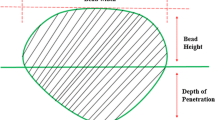Abstract
RBF model, a new type of artificial neural network model was developed to design the content of carbon in low-alloy engineering steels. The errors of the ANN model are: MSE 0.0521, MSRE 17.85%, and VOF 1.9329. The results obtained are satisfactory. The method is a powerful aid for designing new steels.
Similar content being viewed by others
References
Nielsen R H. Neurocomputing [M]. Massachusetts: Addision-Wesley Publishing Company. 1991.
WANG Jia-jun, Pieter Van Der Wolk. Effects of Carbon Concentration and Cooling Rate on Continuous Cooling Transformations Predicted by Artificial Neural Network [J]. ISIJ International, 1999, 39(10): 1038.
Pieter Van der Wolk. Modeling CCT-Diagrams of Engineering Steels Using Neural Networks [M]. Delft: Delft University Press, 2001.
Vermeulen W G, Morris P F, S van der Zwaag. Prediction of Continuous Cooling Transformation Diagram of Some Selected Steels Using Artificial Neural Networks [J]. Steel Research, 1997, 68: 72.
The No. 1 Iron Factory of Benxi Iron and Steel Corporation, Tsinghua University. The Atlas of Super-Cooling Austenite Transformation Diagrams [M]. Benxi: The No. 1 Iron Factory Press of Benxi Iron and Steel Corporation, 1978.
American Society for Metals. Atlas of Isothermal Transformation and Cooling Transformation Diagrams [M]. Metals Park, Ohio: American Society for Metals Press, 1977.
ZHANG Shi-zhong. Atlas of Super-Cooling Austenite Transformation Diagrams [M]. Beijing: Metallurgy Industry Press, 1993.
Ha’erbin Research Institute of Welding of Machinery and Electronical Industry Ministry. CCT Atlas of Welding of Low Alloy Steels [M]. Beijing: China Machine Press, 1990.
Japan Society for Irons and Steels. Atlas of CCT of Welding Steels [M]. Tokyo: Japan Society for Iron and Steels, 1992.
Japan Society for Irons and Steels. Atlas of Continuous Cooling Transformation Diagrams of Low Carbon Steels [M]. Tokyo: Japan Society for Irons and Steels, 1992.
So Sung-Sau, Martin Karplus. Evolutionary Optimization in Quantitative Structure-Activity Relationship: An Application of Genetic Neural Networks [J]. Journal of Medicinal Chemistry, 1996, 39(7): 1524.
Author information
Authors and Affiliations
Corresponding author
Rights and permissions
About this article
Cite this article
You, W., Liu, Yx., Bai, Bz. et al. RBF-Type Artificial Neural Network Model Applied in Alloy Design of Steels. J. Iron Steel Res. Int. 15, 87–90 (2008). https://doi.org/10.1016/S1006-706X(08)60038-2
Revised:
Published:
Issue Date:
DOI: https://doi.org/10.1016/S1006-706X(08)60038-2




